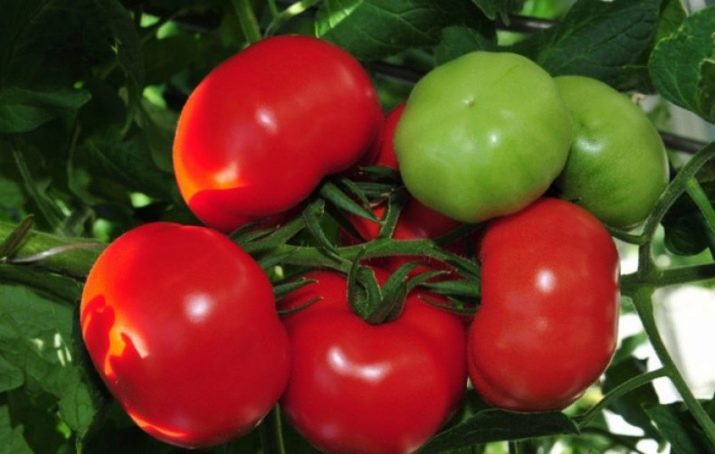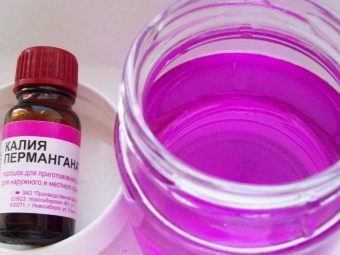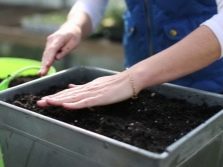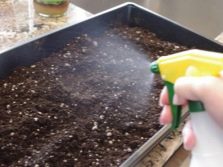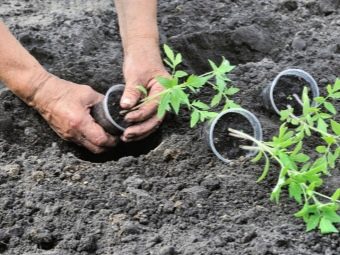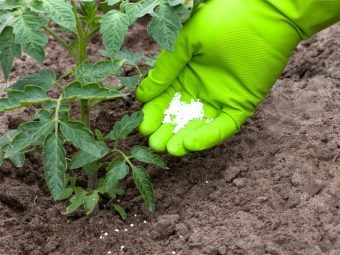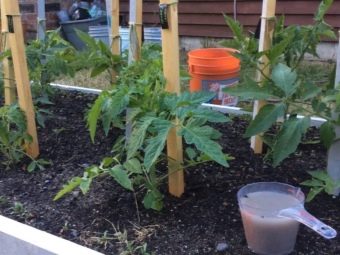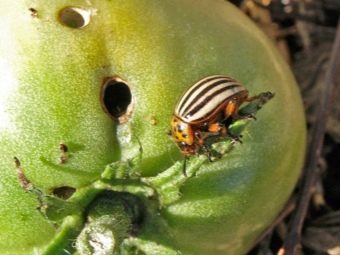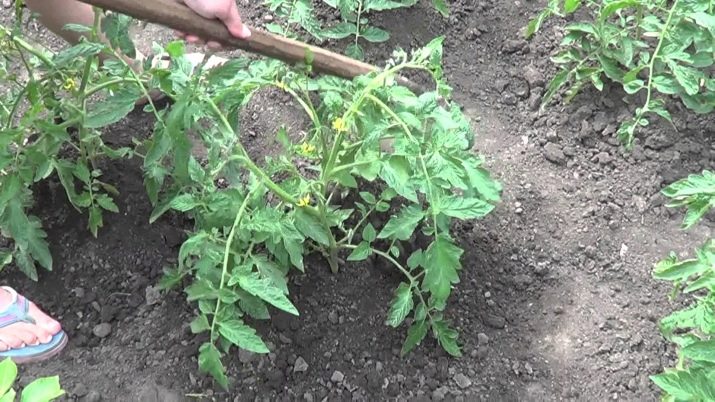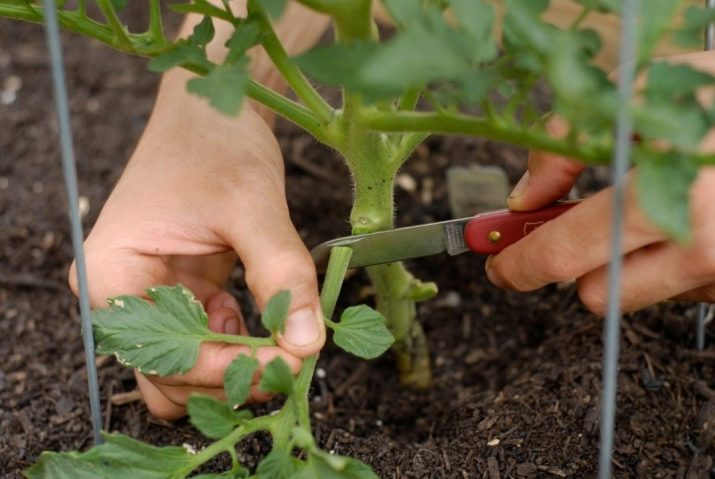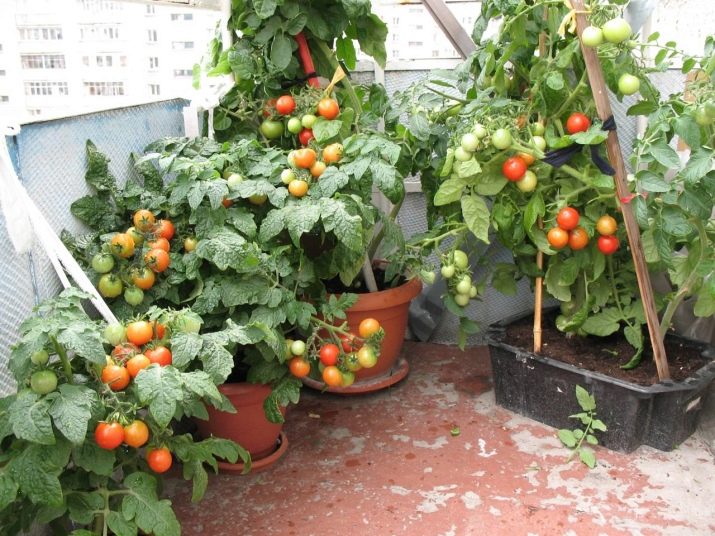Tomato "Boni MM": distinctive features and features of cultivation

If you want to get an early crop of tomatoes and are not ready to grow large bushes that require a lot of space on the site, pay attention to the variety "Boni MM".Its advantages are also unpretentious care and high yields. In the State Register the variety is registered as “Boni MM”, although it is possible to find the option “Boni M” on sale. These differences are purely marketing; they are the same brand.
Variety description
The tomato "Boni MM" is an early ripe variety with shrubs of deterministic type. Fruit ripening occurs at 85-88 days after the appearance of seedlings. The bush is formed small, up to 50 cm high, so it does not need to be tied up. Passing and pinching the tops is also not required. Designed for cultivation in the open field, although you can do it in greenhouse conditions. The variety demonstrates high yield, the fruits ripen almost simultaneously, so the entire crop is removed on average for 2-2.5 weeks.
Due to ripening in mid-summer, Boni MM tomatoes are less prone to late blight.
Tomatoes grow roundish with a slight ribbing, bright red color. The mass of one fruit is 70-100 g. Up to 2 kg of fruits are gathered from a bush, from 1 square meter. m average 6-7 kg. The crop can be consumed fresh or conserved. Tomatoes have tender juicy pulp without pronounced sweetness or sourness and elastic skin. Due to this, they can be transported over long distances and stored for a certain time.
Landing
It is recommended to sow this variety 55-65 days before the intended landing in the ground. If you plan on eating tomatoes in early June, then you need to sow them in early March. If cultivation is expected in the northern regions, it is better to plant seedlings under the film. In this case, you can plant it in the last third of March.
You can sow seeds in early May, but planted in the ground, like the bushes planted earlier, no later than the beginning of June.
Before planting, seeds are recommended to be prepared - to sort, disinfect, process with a growth promoter. This will improve germination rates, awaken plants, increase their resistance to infections and adverse environmental factors. To determine the lungs, which means empty seeds allows simple manipulation - the seeds need to be immersed in water. Those that float, unsuitable for landing, should be used only dropped to the bottom.
Next, the seeds are disinfected by immersion in a weak solution of potassium permanganate. It is prepared from a liter of warm water, in which 1 g of potassium permanganate is dissolved. It is more convenient to wrap the seeds in cheesecloth by making a bag, and lower it for 15-20 minutes in a disinfecting solution. After that, the seeds are washed and soaked for 12 hours in a solution of the biostimulator.
For growing it is recommended to use disposable pots for seedlings, since with this method the root system suffers less during transplantation. For this variety is important. Use should be a special soil for tomatoes. You can buy it in a specialized department or make it yourself by mixing 2 parts of humus and soddy soil, adding 1 part of sand and a tablespoon of ash. It is recommended to pre-heat the soil in the oven or disinfect with a solution of potassium permanganate.
At the bottom of the tank for growing put drainage, then lightly tamped soil. Before and after planting seeds moisten the soil. Seeds are sown on 2-3 per glass, sprinkled with earth. Now they need to close the film and leave at a temperature of 23-25 C until the first shoots. Every day, you need to open the film for 5-10 minutes, and if necessary, moisten the ground. The film is removed when most of the seed rises. A week after that, they are quenched, placed in conditions with a temperature of 15-18 C for several days. After the appearance of 2-3 leaves you need to make a pick of the plant.
Watered the plant every 5-7 days with warm distilled water. From carrying out feeding in this period can be waived. It is important to ensure the plant a long light day, if necessary, highlighting the tomatoes with a special lamp.2-3 weeks before landing in the ground it is necessary to harden the bushes. To do this, they are taken out on an unglazed balcony or on the street, first for 15-30 minutes, then for 2-3 hours, and then for the whole day.
For “walks” one should choose a dry, windless place, in the first days it is recommended to shade the bushes. The minimum temperature should be at least +12 C. The hardening procedure will allow the bushes to adapt more quickly to growing conditions in the future.
Transplantation into the ground should be made no later than 55-65 days after planting seeds. In the greenhouse it can be done earlier. You need to be guided by weather conditions - at night there should be no frosts below +10 C, and the soil should be heated to 15-18 C. Tomatoes are transplanted into shallow holes, and abundantly watered during planting. This should be done in a warm, windless evening. It is better to prepare the soil in the fall - dig, make humus. Immediately before planting, disinfect the wells with a solution of potassium permanganate, add mineral fertilizer. The density of the bushes should be 6-7 per 1 square. m
Care
Since South America is home to the variety, it is quite resistant to the effects of high temperatures and exposure to direct sunlight. But excessive watering can ruin the plant. It is recommended to carry it out every 7 days, pouring at least 1-1.5 liters of water under the root of a bush. In hot weather, mulching is recommended to preserve moisture and prevent overheating of the earth. Frequent watering in small portions is necessary only in the first week after transplantation into the ground. This will allow the plant to quickly adapt and grow roots.
2 weeks after disembarking, mineral fertilizing is introduced. Further fertilization can be repeated every 10-14 days. This variety does not need to be staved, but the lower leaves must be cut off. They do not participate in photosynthesis, but at the same time take away nutrients from the bush. In addition, in contact with the ground, these leaves can cause infection of plants.
Peel the leaves in the morning when the weather is dry and warm. On a rainy day, it is better not to carry out these manipulations - the likelihood of the stem decaying is high.
Diseases and pests
Gardeners appreciate this variety in many respects for the fact that it is almost not susceptible to diseases and pest attacks. This is due to its early ripeness - the bush has time to give the crop before the onset of pest infestation and the appearance of phytophthora. The only danger is slugs affecting the roots and stems of "Boney MM" tomatoes. For pest control should use specialized formulations.
Soil water will allow to drive out aphids and mites. It can also be used to disinfect the soil with a slug attack. You should use soap, dissolving it in water until it becomes cloudy, and an opaque soap film is formed on its surface.
In the fight against Colorado beetles (sometimes their appearance coincides with the life of the variety) is destroyed by special insecticides. It is necessary to make processing of bushes in the evening when daytime heat will subside. It is important to spray the leaves outside and inside.
To avoid the appearance of fungi allows proper care - this is compliance with the drinking regime and loosening the soil. When grown in a greenhouse, it is important to provide air exchange within this design and monitor the humidity of the air.
Tips experienced gardeners
Experienced gardeners use the following tricks when growing tomatoes of this variety.
- When planting directly into the ground, the seeds are covered with a film. Her pull on the arc of metal rods. Such protection should be maintained until 2-3 leaves appear on the seedlings. Then you need to cover the seedlings when frost.
- After 4-5 days after transplantation into the ground, the bush should be spud. This will increase the growth of new roots, which will allow the bush to get stronger and get used to new growing conditions faster.
- In the period of ripening tomatoes, it is recommended to mulch the soil. This will help to maintain the desired level of soil moisture, because the lack and excess moisture equally adversely affect the yield. In addition, even if a ripe tomato falls, it will not touch the ground and will not rot.
- The following method allows to speed up the fruiting, to increase the yield. The top of the bush must be split lengthwise using a blade or a sharp knife. In this place you should install a wooden stick. The bush will not be able to grow the stem and at the same time will be in a stressful situation, which will cause an increase in the number of fruits.
- If you break off small fruits located at the bottom of the brush, the tomatoes growing above can gain mass.
Reviews
In most reviews of gardeners, the tomato "Boni MM" received a positive response. It is recommended in cases where an early harvest is needed. This makes tomatoes optimal for growing in the northern regions and regions with a short summer. Gardeners note the compactness of the bushes, the possibility of their more dense planting in the ground without affecting the fruiting.
However, despite the manufacturer’s assertion that there is no need for a garter, it’s still necessary to do so. Otherwise, the bush breaks under the weight of the fruit.
These tomatoes get a positive assessment when grown in a greenhouse. In the network you can find reviews that the first harvest was taken after the 20th of May when planting seedlings in the greenhouse in early April. Seeds in this case were sown before March 10. The only drawback with a similar breeding method is smaller fruits weighing up to 50 g. However, experienced gardeners say that the reason for this is not growing in a greenhouse, but a lack of fertilizers.
As for taste, opinions are divided. Some say that the tomato has a good, pleasant taste (sometimes a remark is made “for the early ripe variety”), while others note the mediocrity of taste.
See the following video for reviews on the Boni MM variety tomate.

